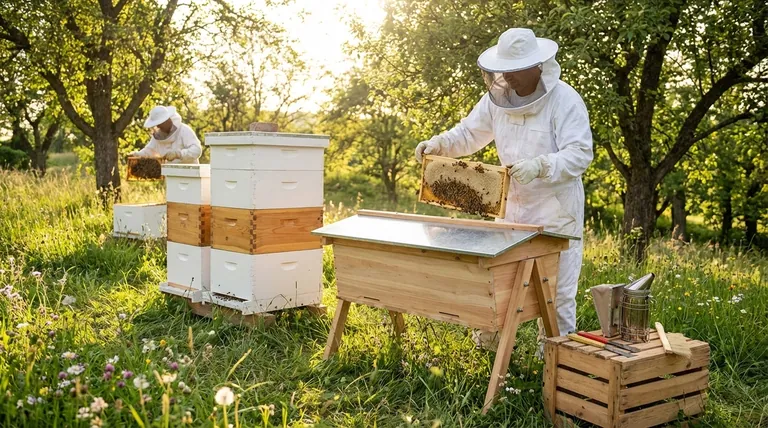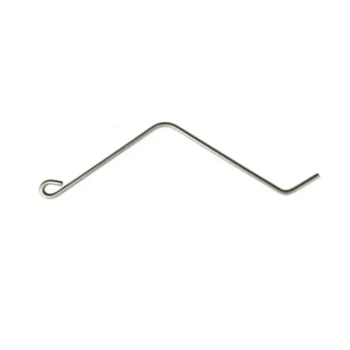Choosing between a Langstroth and a Top Bar hive is a foundational decision in beekeeping. The fundamental difference lies in their structure and management philosophy. The Langstroth hive is a system of vertical, stackable boxes containing removable frames, optimized for honey production and equipment standardization. In contrast, the Top Bar hive is a single, horizontal trough where bees build their comb naturally downwards from simple wooden bars, promoting a less intrusive, more bee-centric style of management.
Your choice hinges on a fundamental trade-off: The Langstroth hive is a standardized system optimized for honey production and interchangeability, while the Top Bar hive is a simpler, self-contained system that prioritizes natural comb and a less physically demanding management style.

Core Design Philosophy: Vertical vs. Horizontal
The Modular Langstroth System
The Langstroth hive is the most recognizable design in modern beekeeping. It consists of a series of interchangeable boxes stacked vertically.
Bees build their comb on removable frames that typically hold a sheet of foundation, guiding them to build straight, uniform combs.
This modularity is its greatest strength. You can add or remove boxes ("supers") to expand or shrink the hive's volume based on the colony's needs and the season's nectar flow.
The All-in-One Top Bar System
The Top Bar hive (TBH) is essentially a long, horizontal trough covered with individual wooden bars. It is a self-contained unit that does not expand vertically.
Bees are encouraged to build their comb by drawing it down naturally from a guide on the underside of each bar. This results in foundationless, naturally shaped comb.
The hive's volume is managed using a "follower board," a movable divider that allows the beekeeper to adjust the space available to the colony.
The Beekeeper's Experience: Inspection and Management
Inspecting a Langstroth Hive
Management involves inspecting the hive box by box and frame by frame. This allows for a thorough assessment of the queen, brood, and food stores.
The key challenge is physical effort. A box full of honey can weigh 50 to 80 pounds, and you must lift them to inspect the boxes below.
Inspecting a Top Bar Hive
Inspections are done one comb at a time, starting from the back. You only lift a single bar, which weighs just 5 to 8 pounds.
This process is far less disruptive to the colony, as the majority of the hive remains covered and undisturbed. However, the naturally-drawn comb is more fragile and must be handled carefully, as it is only attached at the top.
Honey Production and Harvesting
Extraction in Langstroth Hives
Langstroth frames are designed for reuse. The wax cappings are cut off, and the frames are placed in a centrifugal extractor that spins the honey out.
This process preserves the intricate beeswax comb. Since bees must consume roughly eight pounds of honey to produce one pound of wax, reusing comb dramatically increases the hive's potential honey yield.
Crush and Strain in Top Bar Hives
In a Top Bar hive, the entire comb is cut from the bar. The honey is then harvested by crushing the comb and straining it through a filter to separate the honey from the beeswax.
This method is simple and requires no expensive equipment. However, it means the bees must rebuild new comb every year, which consumes significant energy and resources that could have otherwise been stored as surplus honey.
Understanding the Trade-offs
Cost and Accessibility
Langstroth components are standardized and widely available from nearly every beekeeping supplier. This makes sourcing and replacing parts easy.
Top Bar hives are less standardized, but their simple design makes them a popular and accessible DIY project, which can significantly lower initial costs.
Physical Demands
This is a critical distinction. Langstroth beekeeping requires heavy lifting. If you have back problems or limited physical strength, managing multiple deep boxes will be a serious challenge.
Top Bar beekeeping involves no heavy lifting, making it a much more accessible option for people of all physical abilities.
Natural Behavior vs. Efficiency
The "natural" argument is complex. The Top Bar hive's foundationless comb allows bees to build cells of the size they choose, which is considered more natural.
Conversely, the Langstroth's reusable comb saves the bees an immense amount of work. This efficiency is why it is the standard for commercial honey production. Neither system is inherently better for bee health; good management practices are what matter most.
Making the Right Choice for Your Goals
Your beekeeping goals should be the primary driver of your decision.
- If your primary focus is maximizing honey production and using standard equipment: The Langstroth hive is the industry standard for its unmatched efficiency and interchangeability.
- If your primary focus is a less physically demanding, more naturalistic approach: The Top Bar hive is an excellent choice that avoids heavy lifting and allows for foundationless comb.
- If you value a system that minimizes disruption to the colony during inspections: The Top Bar hive's one-comb-at-a-time method is a significant advantage.
- If you plan to expand your operation or move hives frequently: The Langstroth's robust, modular design is far better suited for scalability and transport.
Ultimately, the best hive is the one that aligns with your physical abilities, beekeeping philosophy, and personal goals.
Summary Table:
| Feature | Langstroth Hive | Top Bar Hive |
|---|---|---|
| Structure | Vertical, stackable boxes | Single, horizontal trough |
| Comb | Foundation-based, reusable frames | Foundationless, natural comb |
| Honey Harvesting | Centrifugal extractor (reusable comb) | Crush and strain (comb is destroyed) |
| Physical Effort | Heavy lifting required (50-80 lbs/box) | Minimal lifting (5-8 lbs/bar) |
| Best For | Maximizing honey yield, standard equipment | Natural beekeeping, accessibility, minimal disruption |
Ready to equip your apiary with the right hive and supplies?
As a trusted wholesale supplier for commercial apiaries and beekeeping equipment distributors, HONESTBEE provides the durable, high-quality equipment you need to succeed. Whether you're scaling a Langstroth operation or managing Top Bar hives, we have the supplies to support your goals.
Contact our team today to discuss your wholesale needs and discover how we can help your business thrive.
Visual Guide

Related Products
- Long Langstroth Style Horizontal Top Bar Hive for Wholesale
- HONESTBEE Advanced Ergonomic Stainless Steel Hive Tool for Beekeeping
- Plastic Bee Hive Stand for Beekeeping
- Professional Dual-End Stainless Steel Hive Tool for Beekeeping
- Professional 3-Bar Frame Grip with Integrated Hive Tool
People Also Ask
- What are the box management requirements for a top bar hive vs. Langstroth? Choose Your Hive Strategy
- What are the main differences between Langstroth hives and top bar hives? Choose the Right Hive for Your Beekeeping Goals
- How does the design of a top bar hive benefit beekeepers? Ergonomic & Natural Beekeeping for Hobbyists
- What are the benefits of a top bar hive? A Natural, Low-Impact Approach to Beekeeping
- What are the most popular types of hives besides the Langstroth? Top Bar & Horizontal Hives Explained



















